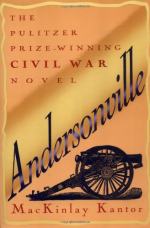Another thing about the Army of the Potomac was the variety of the uniforms. There were members of Zouave regiments, wearing baggy breeches of various hues, gaiters, crimson fezes, and profusely braided jackets. I have before mentioned the queer garb of the “Lost Ducks.” (Les Enfants Perdu, Forty-eighth New York.)
One of the most striking uniforms was that of the “Fourteenth Brooklyn.” They wore scarlet pantaloons, a blue jacket handsomely braided, and a red fez, with a white cloth wrapped around the head, turban-fashion. As a large number of them were captured, they formed quite a picturesque feature of every crowd. They were generally good fellows and gallant soldiers.
Another uniform that attracted much, though not so favorable, attention was that of the Third New Jersey Cavalry, or First New Jersey Hussars, as they preferred to call themselves. The designer of the uniform must have had an interest in a curcuma plantation, or else he was a fanatical Orangeman. Each uniform would furnish occasion enough for a dozen New York riots on the 12th of July. Never was such an eruption of the yellows seen outside of the jaundiced livery of some Eastern potentate. Down each leg of the pantaloons ran a stripe of yellow braid one and one-half inches wide. The jacket had enormous gilt buttons, and was embellished with yellow braid until it was difficult to tell whether it was blue cloth trimmed with yellow, or yellow adorned with blue. From the shoulders swung a little, false hussar jacket, lined with the same flaring yellow. The vizor-less cap was similarly warmed up with the hue of the perfected sunflower. Their saffron magnificence was like the gorgeous gold of the lilies of the field, and Solomon in all his glory could not have beau arrayed like one of them. I hope he was not. I want to retain my respect for him. We dubbed these daffodil cavaliers “Butterflies,” and the name stuck to them like a poor relation.
Still another distinction that was always noticeable between the two armies was in the bodily bearing of the men. The Army of the Potomac was drilled more rigidly than the Western men, and had comparatively few long marches. Its members had something of the stiffness and precision of English and German soldiery, while the Western boys had the long, “reachy” stride, and easy swing that made forty miles a day a rather commonplace march for an infantry regiment.
This was why we knew the new prisoners to be Sherman’s boys as soon as they came inside, and we started for them to hear the news. Inviting them over to our lean-to, we told them our anxiety for the story of the decisive blow that gave us the Central Gate of the Confederacy, and asked them to give it to us.




